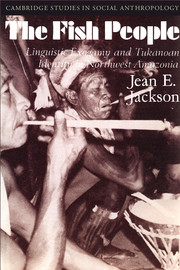Book contents
- Frontmatter
- Contents
- List of figures, maps, and tables
- Preface
- Acknowledgments
- Note on orthography
- 1 Purpose and organization of the book
- 2 Introduction to the Central Northwest Amazon
- 3 The longhouse
- 4 Economic and political life
- 5 Vaupés social structure
- 6 Kinship
- 7 Marriage
- 8 Tukanoans and Makú
- 9 The role of language and speech in Tukanoan identity
- 10 Male and female identity
- 11 Tukanoans' place in the cosmos
- 12 Tukanoans and the outside world
- 13 Conclusions: themes in Tukanoan social identity
- Notes
- Glossary
- References
- Index
- CAMBRIDGE STUDIES IN SOCIAL ANTHROPOLOGY
3 - The longhouse
Published online by Cambridge University Press: 05 June 2012
- Frontmatter
- Contents
- List of figures, maps, and tables
- Preface
- Acknowledgments
- Note on orthography
- 1 Purpose and organization of the book
- 2 Introduction to the Central Northwest Amazon
- 3 The longhouse
- 4 Economic and political life
- 5 Vaupés social structure
- 6 Kinship
- 7 Marriage
- 8 Tukanoans and Makú
- 9 The role of language and speech in Tukanoan identity
- 10 Male and female identity
- 11 Tukanoans' place in the cosmos
- 12 Tukanoans and the outside world
- 13 Conclusions: themes in Tukanoan social identity
- Notes
- Glossary
- References
- Index
- CAMBRIDGE STUDIES IN SOCIAL ANTHROPOLOGY
Summary
The setting
Pṹmanaka buro sits on a hill overlooking an oxbow turn in the Inambú River. Like most settlements, it takes its name from a particular feature of the local landscape, in this case the “hill of many leaves.” Settlements are also known by the headman's Spanish or Indian name. The Inambú (tinamou bird – Tinamus and Crypturellus spp.) is a small river on which five local descent groups – one Bará, four Tuyuka – live at present.
It is difficult to convey how radically the character of a river in this region changes over the course of a year. At low water no English speaker would call the Inambú anything but a creek or stream, and huge logs, debris, and sand dominate the landscape far more than water. Yet at high water the stream grows to a raging torrent. The Inambú's height and volume alter its every aspect: its appearance, its aquatic life, and the amount of time necessary to travel its length.
As is the case with most settlements, on arriving at Pṹmanaka buro one barely sees the longhouse. The canoe landing, however, always shows various signs of human activity. One or more canoes, usually small one-man fishing craft, will be tied to a tree or beached, depending on the shoreline and season. Baskets of soaking manioc tubers may be visible in the water. A woman may be washing clothes, cleaning an animal carcass, or scaling and gutting fish.
- Type
- Chapter
- Information
- The Fish PeopleLinguistic Exogamy and Tukanoan Identity in Northwest Amazonia, pp. 26 - 38Publisher: Cambridge University PressPrint publication year: 1983

